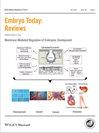E. Scott Sills, Robert E. Anderson, Mary McCaffrey, Xiang Li, Nabil Arrach, Samuel H. Wood
下载PDF
{"title":"Gestational surrogacy and the role of routine embryo screening: Current challenges and future directions for preimplantation genetic testing","authors":"E. Scott Sills, Robert E. Anderson, Mary McCaffrey, Xiang Li, Nabil Arrach, Samuel H. Wood","doi":"10.1002/bdrc.21112","DOIUrl":null,"url":null,"abstract":"<p>Preimplantation genetic screening (PGS) is a component of IVF entailing selection of an embryo for transfer on the basis of chromosomal normalcy. If PGS were integrated with single embryo transfer (SET) in a surrogacy setting, this approach could improve pregnancy rates, minimize miscarriage risk, and limit multiple gestations. Even without PGS, pregnancy rates for IVF surrogacy cases are generally satisfactory, especially when treatment utilizes embryos derived from young oocytes and transferred to a healthy surrogate. However, there could be a more general role for PGS in surrogacy, since background aneuploidy in embryos remains a major factor driving implantation failure and miscarriage for all infertility patients. At present, the proportion of IVF cases involving GS is limited, while the number of IVF patients requesting PGS appears to be increasing. In this report, the relevance of PGS for surrogacy in the rapidly changing field of assisted fertility medicine is discussed. Birth Defects Research (Part C) 108:98–102, 2016. © 2015 Wiley Periodicals, Inc.</p>","PeriodicalId":55352,"journal":{"name":"Birth Defects Research Part C-Embryo Today-Reviews","volume":"108 1","pages":"98-102"},"PeriodicalIF":0.0000,"publicationDate":"2015-11-23","publicationTypes":"Journal Article","fieldsOfStudy":null,"isOpenAccess":false,"openAccessPdf":"https://sci-hub-pdf.com/10.1002/bdrc.21112","citationCount":"3","resultStr":null,"platform":"Semanticscholar","paperid":null,"PeriodicalName":"Birth Defects Research Part C-Embryo Today-Reviews","FirstCategoryId":"1085","ListUrlMain":"https://onlinelibrary.wiley.com/doi/10.1002/bdrc.21112","RegionNum":0,"RegionCategory":null,"ArticlePicture":[],"TitleCN":null,"AbstractTextCN":null,"PMCID":null,"EPubDate":"","PubModel":"","JCR":"Q","JCRName":"Medicine","Score":null,"Total":0}
引用次数: 3
引用
批量引用
Abstract
Preimplantation genetic screening (PGS) is a component of IVF entailing selection of an embryo for transfer on the basis of chromosomal normalcy. If PGS were integrated with single embryo transfer (SET) in a surrogacy setting, this approach could improve pregnancy rates, minimize miscarriage risk, and limit multiple gestations. Even without PGS, pregnancy rates for IVF surrogacy cases are generally satisfactory, especially when treatment utilizes embryos derived from young oocytes and transferred to a healthy surrogate. However, there could be a more general role for PGS in surrogacy, since background aneuploidy in embryos remains a major factor driving implantation failure and miscarriage for all infertility patients. At present, the proportion of IVF cases involving GS is limited, while the number of IVF patients requesting PGS appears to be increasing. In this report, the relevance of PGS for surrogacy in the rapidly changing field of assisted fertility medicine is discussed. Birth Defects Research (Part C) 108:98–102, 2016. © 2015 Wiley Periodicals, Inc.
妊娠代孕和常规胚胎筛查的作用:胚胎植入前基因检测的当前挑战和未来方向
胚胎植入前遗传学筛查(PGS)是体外受精的一个组成部分,需要在染色体正常的基础上选择胚胎进行移植。如果PGS与代孕中的单胚胎移植(SET)相结合,这种方法可以提高妊娠率,减少流产风险,并限制多胎妊娠。即使没有PGS, IVF代孕病例的妊娠率通常也是令人满意的,特别是当治疗使用来自年轻卵母细胞的胚胎并将其转移到健康的代孕母亲时。然而,PGS在代孕中可能有更广泛的作用,因为胚胎的背景非整倍体仍然是导致所有不孕症患者植入失败和流产的主要因素。目前,IVF病例中涉及GS的比例有限,而IVF患者要求PGS的数量似乎在增加。在本报告中,在快速变化的辅助生育医学领域中,PGS与代孕的相关性被讨论。出生缺陷研究(C辑)108:98-102,2016。©2015 Wiley期刊公司
本文章由计算机程序翻译,如有差异,请以英文原文为准。

 求助内容:
求助内容: 应助结果提醒方式:
应助结果提醒方式:


